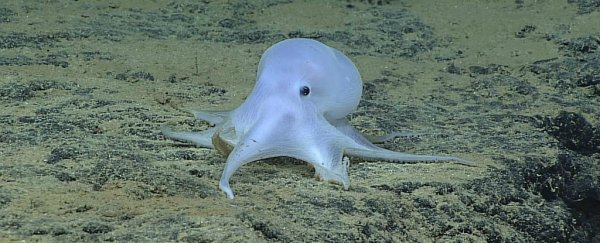Earlier this year, folks across the internet were losing their minds over the discovery of a deep-sea octopus that researchers named Casper for its friendly, yet ghost-like, appearance.
Now, researchers from Germany say they've discovered that the unique animal lays its eggs on top of hard substrates - specifically manganese nodules - on the bottom of the ocean, which also happen to be prime targets for future deep-sea mining, putting the adorable creature in potential danger.
In case you missed the original story, back in March, researchers working with the National Oceanic and Atmospheric Administration's (NOAA) Okeanos Explorer managed to use a remotely operated vehicle (ROV) to capture images of a small, pale octopus at a remarkable 4,290 metres (14,000 feet) under the sea in the Hawaiian Archipelago.
While many of us were thrilled to see such a cute creature, biologists were even more excited, because this marked the first time an octopus was found at such a depth, and potentially represented an entirely new species.
They're still figuring out the exact species, but they've nicknamed it the Hawaiian Casper octopus.
"Until we made these observations, we had assumed that these octopuses only occur at depths of up to 2,600 metres. But the species discovered can now be seen to colonise much greater depths," explains lead author Autun Purser from the Alfred Wegener Institute in Germany.
Now, months after the initial discovery, Purser and his team have discovered more about the creature, specifically how it raises its young at the bottom of the ocean.
"At a depth of 4,000 metres [13,123 feet], these animals had deposited their eggs onto the stems of dead sponges, which in turn had grown on manganese nodules," the team says.
"The nodules served as the only anchoring point for the sponges on the otherwise very muddy seafloor."
The team figured this out by analysing new video footage of 30 similar octopuses taken by cameras on board the robotic ROV KIEL 6000 device at a depth of 4,120 metres (about 13,500 feet) in the Peru Basin section of the south-eastern Pacific Ocean.
"The video footage indicates that the animals have cleaned the seabed around the nodules," said co-author Henk-Jan Hoving, from the GEOMAR Helmholtz Centre for Ocean Research in Germany.
"It probably looks like that because the animals have been filmed using their arms to dig into the sediment around the nodules probably in search for food."
The bad news is that these manganese nodules are very slow growers, taking years to form layer by layer. Since the octopuses need these minerals to survive and reproduce, the nodules are vital to the creature's continued existence.
This problem is compounded by the fact that manganese is a much sought-after mineral for the tech industry because it's commonly used in gadgets like cell phones, making the nodules a prime target for future deep-sea mining activities.
"Many of the metals contained [in manganese nodules] are 'high-tech' metals, useful in producing mobile phones and other modern computing equipment, and most of the land sources of these metals have already been found and are becoming more expensive to buy," Purser told Rachel Feltman at Popular Science.
It's not just the newly found octopus that are threatened by the destruction of deep-sea manganese nodules, either.
An experiment performed in the late '80s - known as the DISCOL experiment - examined the impact of pushing manganese nodules into the ocean floor, making certain areas inaccessible to marine life.
The DISCOL team found that this had a drastic impact on the deep-sea community, with species taking upwards of 26 years to rebound from the experiment.
"The removal of the manganese nodules at that time caused the community of animals that are attached to the seafloor, which also includes sponges, to almost fully collapse," the GEOMAR team reports.
"Even 26 years later many animal populations have not yet recovered."
This suggests that the ecosystem that has allowed the Casper octopus to thrive is extremely delicate.
The good news is that, so far, tech companies that require manganese have been able to use traditional mining to get the amounts they require, reports Feltman, so they haven't resorted to mining the deep sea as yet.
But that might not always be the case. As we continue to make new and exciting devices, the need for these raw materials will increase, which means companies might eventually search for alternative sources of them, such as the bottom of the ocean.
Before that happens, the team urges the research community to investigate safe ways to do so that will not impact the deep-sea communities living there, especially the newly found Casper octopus, which researchers have barely begun to study.
"Our new observations show that we have to know about the behaviour of deep-sea animals and the specific way in which they adapt to their habitat in order to draw up sustainable protective and usage concepts," the team concludes.
The research was published in Current Biology.
